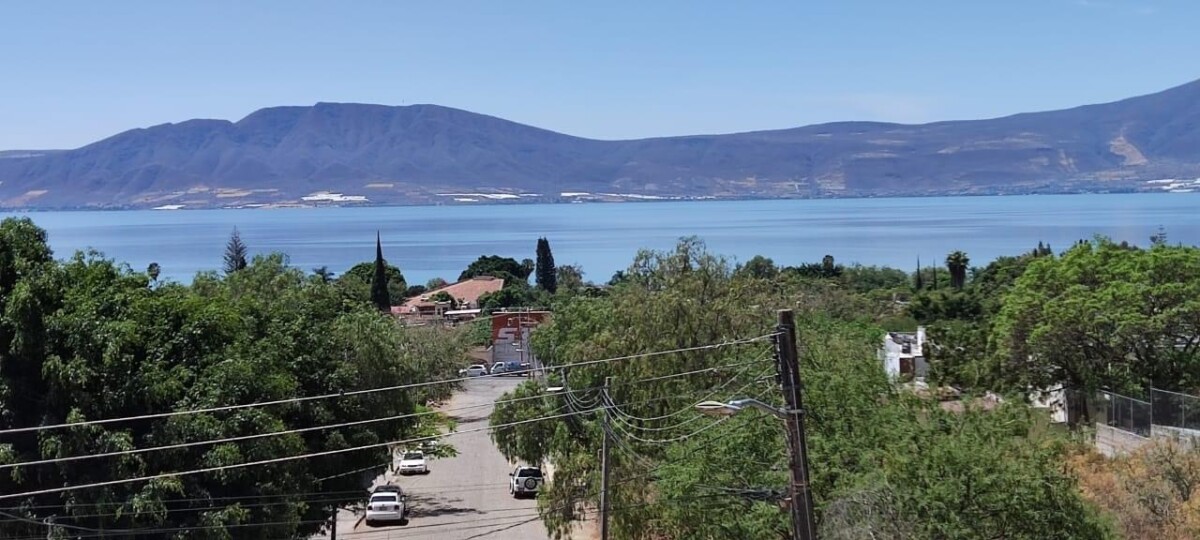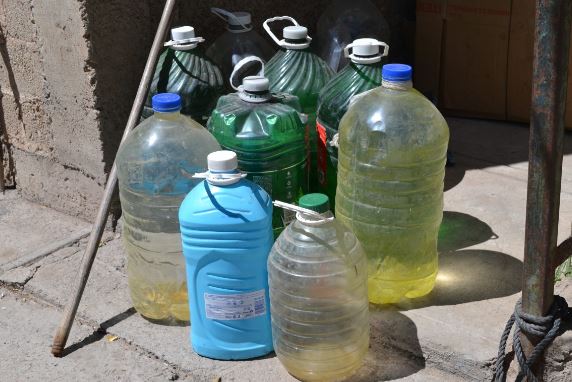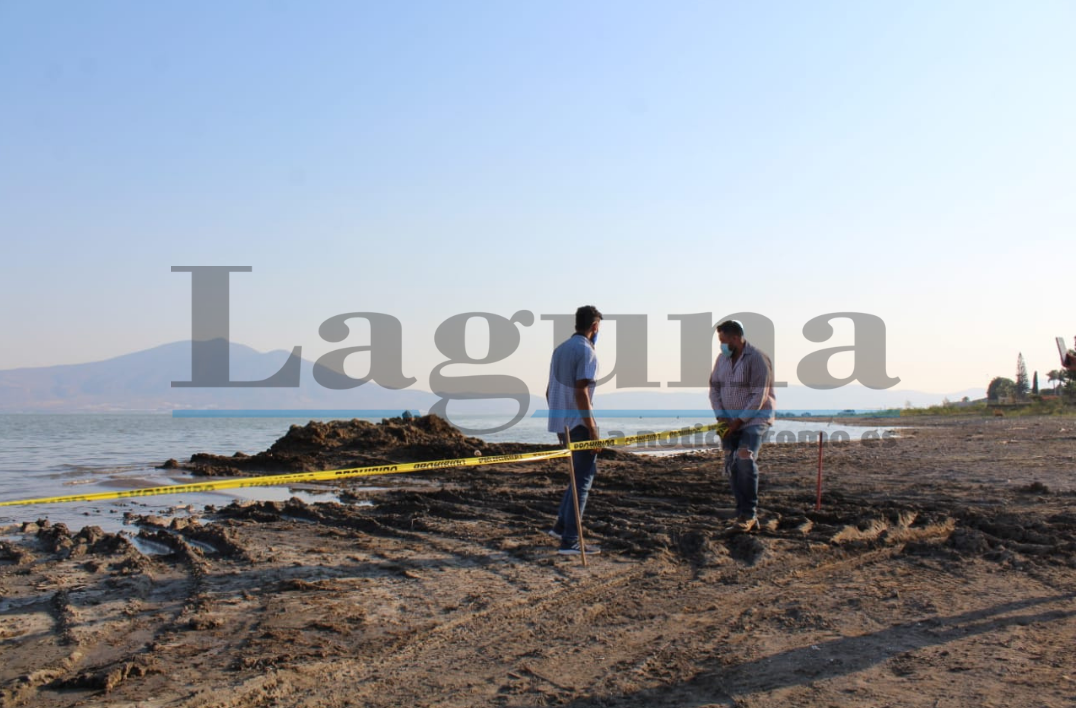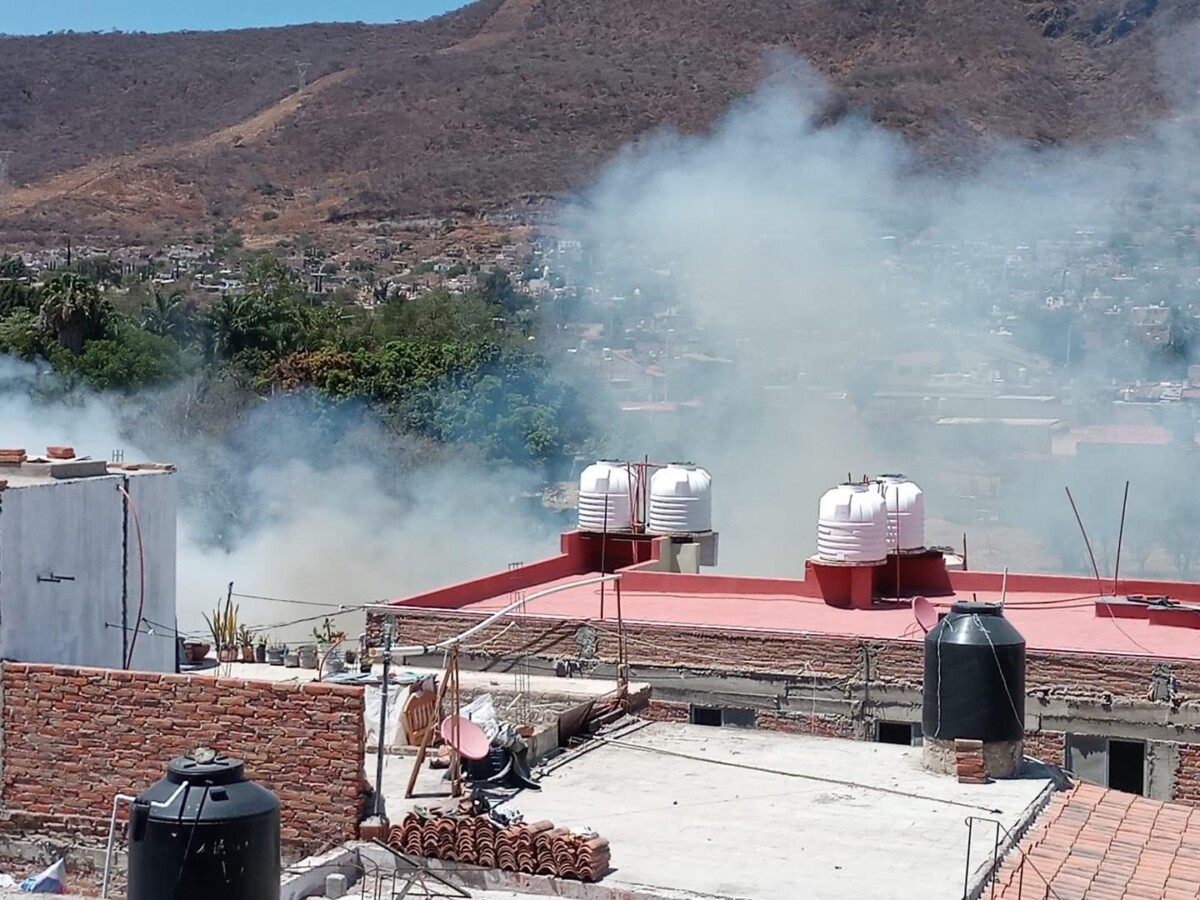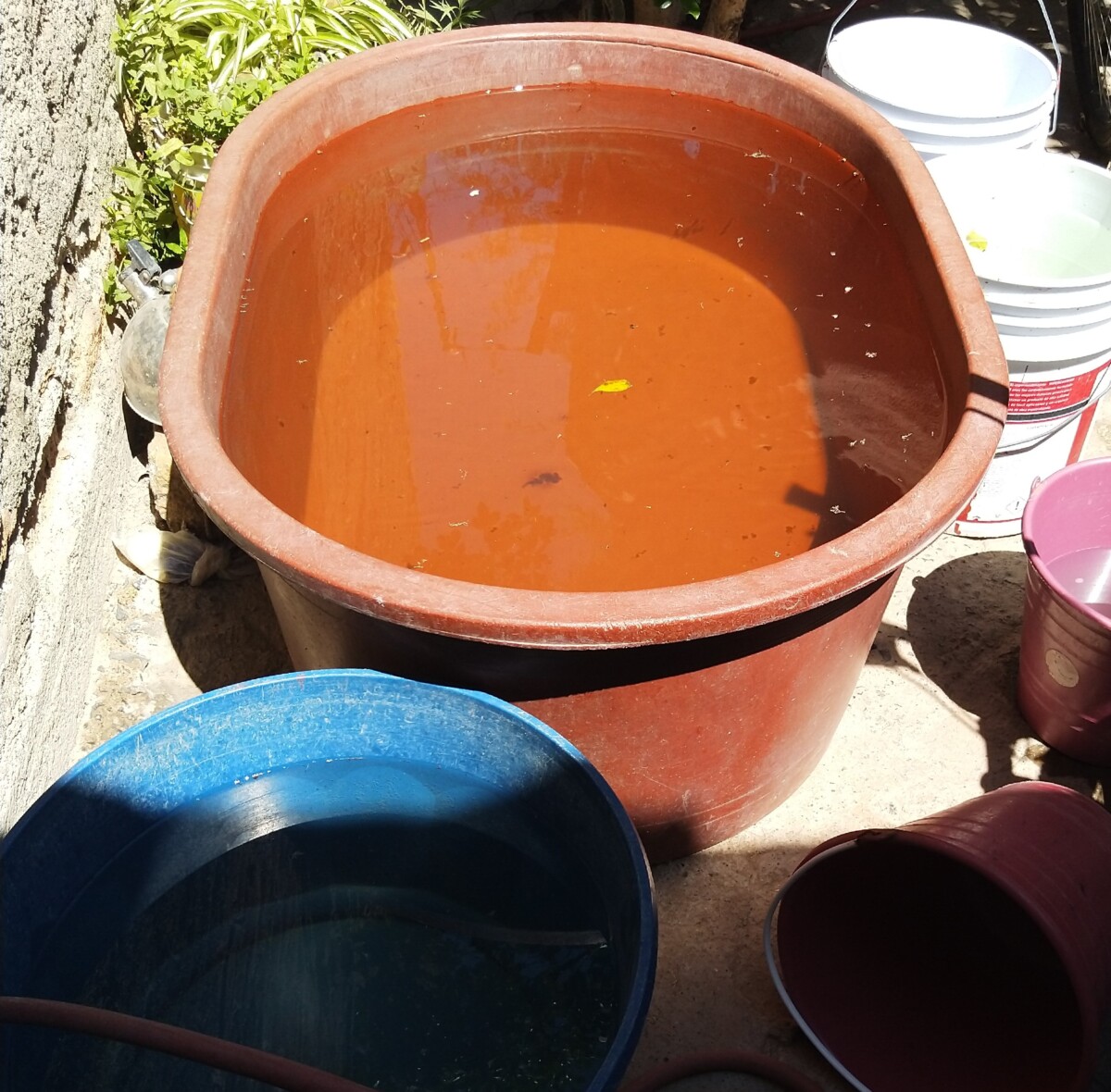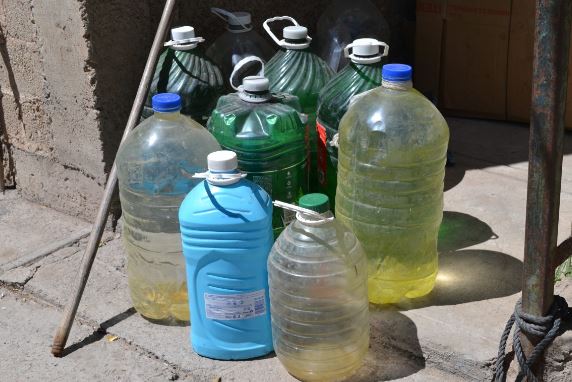Medio ambiente
PHOTONOTE:
During the last rainy season, Lake Chapala reached 74% of its capacity; it is currently at 67%, informed the National Water Commission (CONAGUA).
Despite the decrease in the level, it is still up compared to April 2021, when it was at 51% of its capacity.
Translated by Paul Weeks
Obras cerca del Cerro Colorado causan revuelo entre los habitantes de Ajijic
Imagen donde apenas se alcanza a percibir la máquina trabajando en la montaña. Foto: Ajijic Observatorio Ciudadano.
Sofía Medeles.- Por medio de redes sociales se difundió que maquinaria ha estado trabajando cerca del Cerro Colorado, ubicado al poniente de Ajijic y muy querido por los pobladores.
La publicación se realizó en el grupo de Facebook “Ajijic Observatorio Ciudadano», donde se alcanza a distinguir una excavadora en el lugar de los hechos. En comentarios, se aclara que el lugar se encuentra entre el Cerro Colorado y el cerro Las Tres Cañadas.
El departamento de comunicación social del Gobierno de Chapala aseguró estar al tanto de la situación. Al presentarse inspectores en el sitio, les mostraron licencias para construcción, las cuales, fueron aprobadas durante la administración pasada.
“Se revisó y se encontraron los permisos otorgados en la administración pasada, aunque hay cosas que se notan fuera de lugar. Se está trabajando para revisar y analizar si existen inconsistencias”, afirmó la titular del departamento, Elizabeth Oropeza Silva.
Tanto en redes, como entre las personas, se dice mucho sobre estas obras. Desde que se sabe de varios presuntos dueños del predio y lo que se pretende hacer con ellos, hasta que la Comunidad Indígena de Ajijic, está involucrada.
Asimismo, al menos dos funcionarios salieron a asegurar en la publicación que destapó estos trabajos, que la Dirección de Ecología, entre otras dependencias, se encuentran investigando el caso.
Finalmente, por parte de comunicación social, se agregó que siguen en investigaciones y que por lo que han percibido, el espacio donde están trabajando se ve amplio.
El Cerro Colorado es muy querido por los ajijitecos, ya que es un sitio que alberga leyendas, y es parte de la historia del pueblo y la cultura popular. También es reconocido por visitantes, debido a su peculiar forma, que asemeja la cabeza y el ala de un ave rapaz.
Algunos entrevistados habitantes de Ajijic, cuentan que el cerro ya se ha visto amenazado por la urbanización en algunas ocasiones, más que nada, en la lotificación de terrenos que poseen particulares.
Chapala and Jocotepec faced with ‘severe’ drought”warns Conagua
The return of the drought could affect the supply of drinking water to citizens. Photo: Archive.
Editors.- The Drought Monitor of the National Water Commission (Conagua), reported that Chapala and Jocotepec are among the 57 municipalities of Jalisco that face a «severe» drought level.
According to the agency’s update, 113 of Jalisco’s 125 municipalities have drought conditions ranging from «moderate» to «severe, which means that drought impacts are now felt throughout the state.
Together with the two Lakeside towns mentioned above, all the municipalities that make up the Guadalajara Metropolitan Zone (ZMG), as well as Colotlán, Mezquitic, Ameca, Tala, Lagos de Moreno and Tepatitlán, are the most affected by the situation.
The Conagua’s report detailed that during the last rainy season there was a lack of precipitation in the area of the Western Sierra Madre, as well as warmer than average temperatures in the West Central Region of the country, which contributed to an increase in the drought in Jalisco.
Twelve localities are classified as «abnormally dry» or without problems: Puerto Vallarta, Cabo Corrientes, Cihuatlán, Ayotlán, Cuautitlán de García Barragán, Degollado, Jesús María, Tolimán, Tonila, Tuxcacuesco, San Gabriel and Zapotitlán de Vadillo.
The National Meteorological Service noted that the hurricane season will begin on May 15 in the Pacific Ocean, while in the Atlantic Ocean it will begin on June 1. It is projected that rains will start to return to normal in the second half of June, with tropical waves, cyclones and high humidity.
Translated by Patrick O’Heffernan
Looking at Life in Lakeside:
By: Patrick O’Heffernan
Back in November 2021, our reporter in Jocotepec, Héctor Ruiz Mejía, wrote a story about the trash problem in San Juan Cosalá. He described garbage trucks with no gas, rats invading homes, a school with weeks’ worth of garbage stacked in front of its gates, and more.
Part of the problem is the refusal of Ixtlahuacán de los Membrillos to allow Jocotepec to continue dumping in the GEN landfill, a problem which the municipality is working on. But something else has come to my attention: the deterioration of the Carretera into the landfill that Jocotepec sorely needs.
If you drive from Ajijic to Joco and pass through the happy gauntlet of touts directing your attention to the seafood restaurants that line the lakefront, you won’t notice the piles of garbage lining the highway across from the eateries. In fact, one restaurant even has a large billboard announcing its presence astride a growing pile of garbage and debris.
Garbage, construction debris, junk, and old furniture now l fill open areas of the roadside of the Carretera practically from the county line to Jocotepec. Garbage trucks have nowhere to put what they collect . But people have to put it somewhere and the roadside is the easiest and most available place.
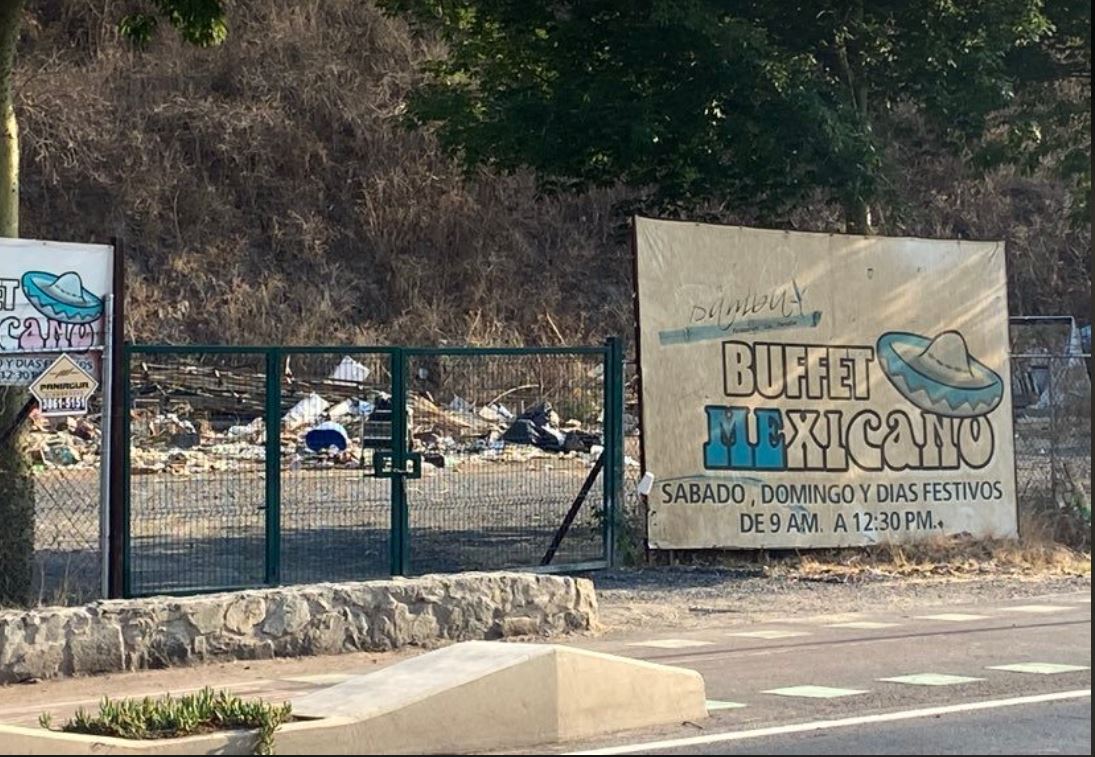
Trash on the Carretera in restaraunt row
But do you really want to take your out of town visitors to any of the great restaurants along the lake when you have to drive through a smelly field of trash? Maybe not – after all there are so many great restaurants in both Chapala and Jocotepec on clean, trash-free streets. Some even have great lake views.
To be fair, you can’t blame the Jocotepec municipality for the problem of the lack of a landfill and you have to cheer them for trying to solve it. The Carretera – Highway 23 – is Federal property; neither the state nor the municipalities have the authority nor the funds to clean it. And it is not fair to ask businesses along the Carretera to clean up the piles every day; that is what they pay taxes for. And where would they put it?
Perhaps the solution lies in the kind of collaboration and citizen action we have seen in Ajijic and Chapala. Until Jocotepec acquires a landfill, Expats and Mexican citizens and local businesses can raise funds, purchase a dedicated garbage truck, lease a piece of land, fence it and clean up the highway until Jocotepec has the funds and a landfill.
Yes, the Carretera Federal is managed by the Secretaría de Comunicaciones y Transportes, SCT) and it is the Federal government’s responsibility. But let’s face it, the garbage would completely block the highway before the SCT got around cleaning the roadside.
In Chapala, expats have purchased fire trucks for the Bomberos. Why not a garbage truck for the Jocotepec Carretera? In Ajijic, the delegado has organized citizens to fill potholes; why not similar brigadistas in Joco to load trash from the roadside into the truck and haul it to a properly fenced and managed leased site.
This is a temporary solution to be sure, but the investment and the collaboration will last a long time and give the Jocotepec government and people an opportunity to show how well they care for their community . And might even pay for itself in increased business to the lakeshore restaurants.
Descarta la FGR denuncia por dragado en el Lago en playa de Ajijic
Clausura simbólica del dragado reportado en Alceseca, el pasado mayo del 2021. En la foto se pueden observar las huellas del trabajo recién realizado por la maquinaria. Foto: Archivo.
Sofía Medeles.- La Fiscalía General de la República (FGR) descartó la denuncia interpuesta por activistas de Ajijic, por el dragado en el territorio federal del Lago de Chapala en la playa conocida como la Alceseca.
Esta denuncia dirigida a quien resultara responsable se presentó en junio del año pasado, señalando la extracción de arena por un dragado para la construcción de un muelle flotante.
Al menos cuatro abogados de Ajijic acompañaron el proceso legal por aproximadamente diez meses, para que tanto la FGR como la Comisión Nacional del Agua (CONAGUA) desecharan el caso, ya que no encontraron pruebas en el lugar de los hechos, pese a las múltiples evidencias presentadas por los ajijitecos.
“La denuncia se presentó en la sede de la FGR en Ocotlán, ya que es a la que corresponde la región. La Policía Investigadora arribó a la zona a realizar sus investigaciones, y en agosto nos dijeron que debíamos ir a CONAGUA a denunciar. Se envió un oficio a CONAGUA, el cual nunca fue respondido, así que se inició un amparo, que se solucionó en diciembre, donde se determina que la institución está obligada a realizar sus investigaciones para continuar con el caso”, informó uno de los abogados consultados.
El entrevistado compartió que al realizar la CONAGUA un recorrido por la zona, resolvió que no se encontró nada de lo denunciado, por ende, la Fiscalía dispuso que no había delito que perseguir, dejando de lado, tanto el acta de hechos que un notario hizo el día la detención del dragado, como las múltiples fotografías, videos, y testigos que documentaron el hecho.
“Fue cansado, porque fue un proceso legal en tiempo y forma. En la manifestación ante CONAGUA, quienes recibieron a los manifestantes, los alentaron a denunciar por la vía legal, cosa que es una contradicción por su actuar en este proceso. Fue un ejercicio revelador en el mal sentido, ya que dejan entrever la falta de capacidad y vocación. A la autoridad no les importan los temas ambientales, y si instituciones federales no les interesa, a las municipales o estatales, menos. Esto queda como antecedente para evidenciar la negativa de las autoridades para intervenir”, aseguró el abogado.
El dragado fue denunciado el 20 de mayo del 2021 mediante redes sociales con videos que captaron como varios camiones de volteo sacaron varios viajes de arena.
La denuncia formal ante la FGR se presentó en junio del 2021. En enero de este año fue cuando se anunció que el amparo había sido solucionado, pidiendo a la CONAGUA colaboración para esclarecer el señalamiento ilícito. En recientes fechas, se prescindió del caso, por “no haber nada en la playa” donde ocurrió el dragado.
Garbage continues to be burned in Jocotepec
The smoke reached several neighboring homes.
On Saturday, April 23rd, a property in the town of La Loma was set on fire and generated a large column of smoke that reached several houses, leaving them full of ash. The fire and smoke alerted the neighbors who alerted Civil Protection and Firefighters, who arrived at the site to control the situation.
Translated b y Patrick O’Heffernan
San Juan Cosalá suffers from water shortages and increased heat
Faced with water shortages in San Juan Cosalá, citizens opt to get containers for water. Photo: Alma Serrano
Alma Serrano (San Juan Cosalá).- The drought is worsening and the solutions have not arrived. Inhabitants of the delegation of San Juan Cosalá continue to suffer from the shortage of drinking water.
After the collapse of the Zaragoza well in March of last year and the usual shortage typical of the hot season, the people of San Juan Cosalá have had to adapt to living with the limited availability of water.
«I bought a tub that holds about 200 liters of water to conserve it when there is nothing. We use it to wash dishes normally, and when there is no water in the water tank, we also use it for the bathroom, because there is not always enough to wash clothes, so in the house we wash practically what we need because we don’t know when we will have no water,» commented a 60 year old resident.
Although both the operator of Agua Potable, Samuel Tolentino Alvarado, and the delegate, Carlos Vázquez Reyes, said that they were working to solve the problem, so far the shortage persists.
Citizens say that they have had at least four months with little water and they are dissatisfied with the action to solve the problem.
«It’s been a long time and you get tired of hauling water, of being aware of when there will be water, of managing and prioritizing it, and there has been no solution,» said an annoyed resident.
It was last March 13 when the municipal authorities announced the collapse of the Zaragoza well due to a failure in the motor, severely affecting the supply of drinking water to the homes in San Juan Cosalá.
«The motor was damaged because the well is throwing a lot of sand and the sand gets inside the motor, and while it is being sucked up it jams it. The operators have to remove the motor and maybe they will restore the well or build a new structure to put in another motor», explained Samuel Tolentino, the water operator.
Translated by Patrick O’Heffernan
Complaints of attempted dispossession by ‘real estate mafia’ increase
Irregular entrance to a property located in La Canacinta, on Lirios Street. Photo: Archive.
Editor.- At least four cases of alleged attempts of property dispossession have surfaced in recent months in the municipality of Chapala, thanks to legitimate owners and citizens who pointed out irregularities in the paperwork of the properties and in the actions of the authorities and former officials involved.
The last case occurred last Wednesday, April 27, in the area of La Canacinta, west of Ajijic, on Lirios Street, where José Contreras Ortega has owned a property for approximately 55 years, which is now in court because people claiming to own the property have appeared.
Although there has been no resolution of the litigation, the supposed new owners, with the help of lawyers, workers and municipal police -who witnesses said that they were mocking and arrogant-, forced their way onto the property containing some of Contreras Ortega’s belongings and livestock.
Both José Contreras Ortega and his relatives said that, being an elderly man and unable to read and write, these characters took advantage of him, denying that anyone other than him could read the documents they had, and only giving his family a notice of a hearing to occur.

Machine used for the attempted eviction in La Floresta, in Ajijic. Photo: Facebook.
«They wouldn’t show us anything. If it was real, they would have a judge’s verdict, eviction order or something. They just gave us a notice for a hearing that is scheduled for May. The lawyer is the one who has been handling the case, as my father does not know how to read or write, he just gives him the corresponding payments to do things,» said one of Don José’s daughters. Some other witnesses pointed out that this lawyer has been linked to irregular legal processes.
In the end, the Contreras family opted to take legal action the following day, presenting their evidence and the notification they never received, claiming they thought that the trial was still ongoing. As a result of this situation, Contreras Ortega had to move their cattle to a property that was loaned to them next to the one where they were originally located.
On Saturday, April 23, several people affected by the attempted dispossession met to tell their cases to the media. Both the Ibon family from Ajijic and the López family from Santa Cruz de la Soledad, along with a member of the Indigenous Community of San Antonio Tlayacapan, presented their cases, linking the Covarrubias brothers to the dispossession of Ajijic and Santa Cruz, and mentioning several former presidents involved in the Chapala ejido, which has sought to appropriate the communal land of San Antonio.
In this meeting, the names of both municipal authorities and ex-officials, as well as institutions such as the Pension Institute of the State of Jalisco (IPEJAL), were mentioned, which they described as «bribed» or «sold».
All the affected families agreed that they will publicize all the cases and all those involved, so that precautions and actions are taken against those involved.
Translated by Patrick O’Heffernan
Registran Chapala y Jocotepec sequía ‘severa’, advierte la Conagua
El recrudecimiento del estiaje podría afectar en el abasto de agua potable de la ciudadanía. Foto: Archivo.
Redacción.- Se recrudecerá el estiaje. El Monitor de Sequía de la Comisión Nacional del Agua (Conagua), reportó que Chapala y Jocotepec se encuentran entre los 57 municipios de Jalisco que presentan un nivel de sequía “severa”.
De acuerdo con la actualización del órgano, en 113 de los 125 de Jalisco hay condiciones de sequía entre “moderada” y “severa”, por lo que la afectación por el estiaje será prácticamente generalizada en la entidad.
Junto a las dos poblaciones ribereñas mencionadas, todos los municipios que integran la Zona Metropolitana de Guadalajara (ZMG), así como Colotlán, Mezquitic, Ameca, Tala, Lagos de Moreno y Tepatitlán, son los más afectados por la situación.
La Conagua detalló que en el pasado temporal de lluvias se registró falta de precipitación en la zona de la Sierra Madre Occidental, así como temperaturas más cálidas que el promedio en la Región Centro Occidente del país. Estas causas incrementaron la sequía en Jalisco.
En contraste, son 12 las localidades clasificadas como “anormalmente secas” o sin problemas: Puerto Vallarta, Cabo Corrientes, Cihuatlán, Ayotlán, Cuautitlán de García Barragán, Degollado, Jesús María, Tolimán, Tonila, Tuxcacuesco, San Gabriel y Zapotitlán de Vadillo.
Por otro lado, el Servicio Meteorológico Nacional recordó que la temporada de huracanes iniciará el 15 de mayo en el Océano Pacífico, mientras que en el Atlántico es a partir del 1 de junio . Se proyecta que las lluvias comenzarán a regularizarse en la segunda quincena de junio, con las ondas tropicales, ciclones y el ingreso de humedad.
Con información de El Informador.
Consume incendio 45 hectáreas forestales en Mezcala
El incendio en el cerro de El Comal consumió 45 hectáreas de bosque. Foto: Ayuntamiento de Poncitlán.
Redacción.- Al menos 45 hectáreas forestales fueron consumidas tras un incendio registrado del Área Natural Protegida del cerro El Comal, en la comunidad de Mezcala de la Asunción, municipio de Poncitlán, durante la mañana del 25 de abril.
Más de 10 horas de trabajo y 26 descargas de agua de la presa de San Juan Tecomatlán, acarreadas por el helicóptero “Witare” de La Secretaría de Desarrollo Territorial (SEMADET), fueron necesarias para controlar el incendio.
El incendio que inició a las 11:00 de la mañana del pasado lunes, tuvo la participación de la Asociación Intermunicipal para la Protección del Medio Ambiente y Desarrollo Sustentable (AIPROMADES) del Lago de Chapala, además de 15 voluntarios de Mezcala, 10 d Casa Blanca y de las autoridades municipales.
© 2016. Todos los derechos reservados. Semanario de la Ribera de Chapala
